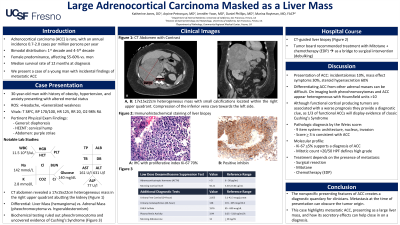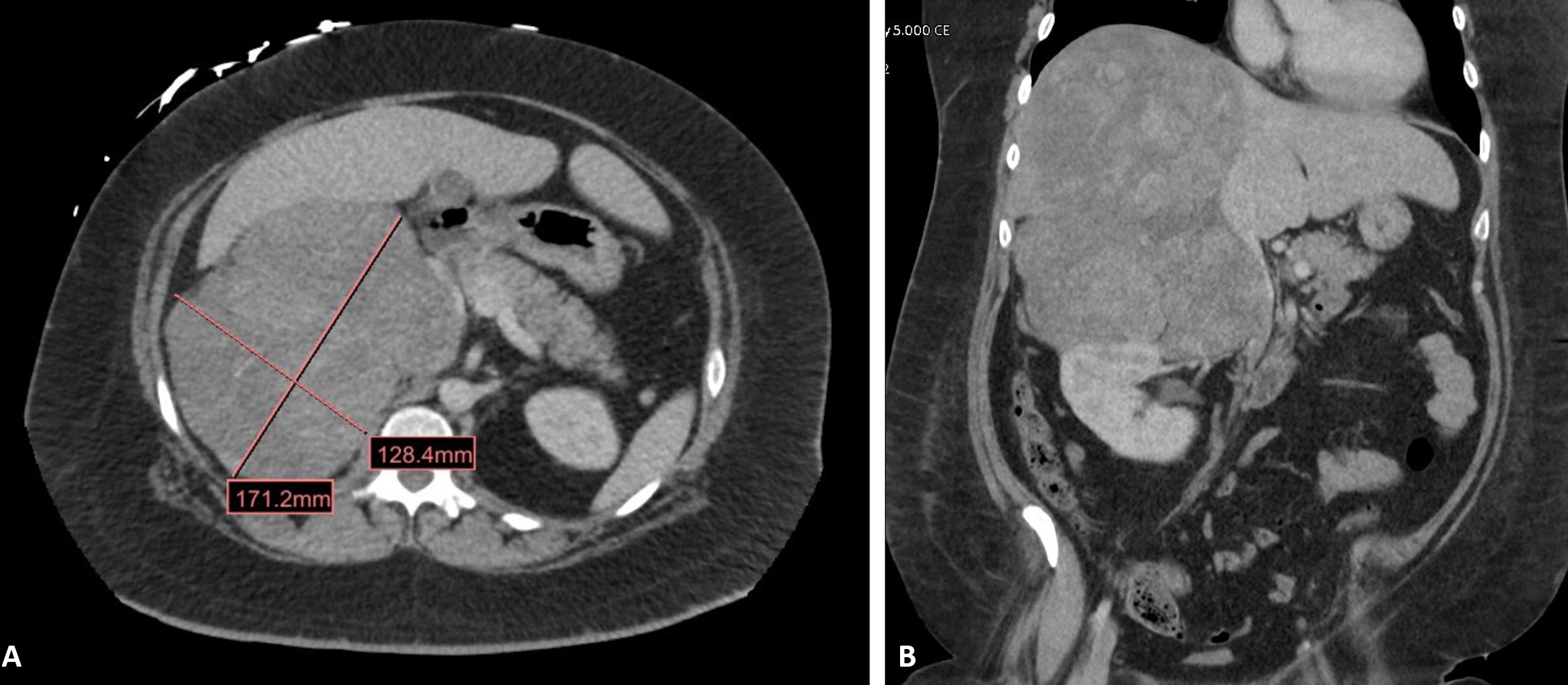Tuesday Poster Session
Category: Liver
P4819 - Large Adrenocortical Carcinoma Masked as a Liver Mass
Tuesday, October 29, 2024
10:30 AM - 4:00 PM ET
Location: Exhibit Hall E

Has Audio

Katherine O. Jones, DO
UCSF Fresno
Fresno, CA
Presenting Author(s)
Katherine O. Jones, DO, Arpine Petrosyan, MD, Jennifer Yoon, MD, Marina Roytman, MD
UCSF Fresno, Fresno, CA
Introduction: Adrenocortical carcinoma (ACC) is an extremely rare malignancy, carrying an annual incidence of 0.7-2.0 cases per million persons per year. It has a bimodal distribution within the first decade of life and between the fourth and fifth decades of life, affecting women at a rate of 55-60% compared to men. Given the aggressive nature of ACC, metastatic disease is common at the time of diagnosis, making timely identification of critical importance. Here we present a case of a young man with incidental findings of metastatic ACC.
Case Description/Methods: A 30-year-old man with a history of obesity and untreated anxiety presented to the emergency department after being found altered near a local airport. On presentation he was found to be diaphoretic, hypertensive, and tachycardic. Physical exam notable for a protuberant abdomen with purple striae. Workup revealed significant hypokalemia and markedly elevated liver enzymes with a hepatocellular pattern of injury. Follow up CT abdomen with contrast revealed a 17 x 15 x 22 cm heterogeneous mass located within the right upper quadrant. Initially it was unclear whether the mass was arising from within the liver or metastasizing to it. Given the clinical presentation, pheochromocytoma was also of concern, however biochemical testing was negative. Instead, low dose dexamethasone test revealed elevated cortisol and low adrenocorticotropic hormone consistent with Cushing’s syndrome. Subsequent CT guided biopsy with histologic analysis revealed positive melan-A and negative chromogranin, consistent with the diagnosis of ACC. Ultimately, he was deemed a candidate for neoadjuvant therapy with etoposide, doxorubicin, cisplatin and mitotane as a bridge to surgical resection.
Discussion: The presentation of ACC depends on the functional status and size of the tumor at the time of diagnosis and can range from asymptomatic incidentalomas, to functional tumors with steroid hypersecretion. Incidental diagnosis accounts for an estimated 10% of patients with ACC, while mass effect and steroid hypersecretion are more commonly observed. In fact, one third of those identified with functional tumors will meet criteria for Cushing syndrome. The nonspecific presenting features of ACC create a diagnostic quandary for clinicians, which can delay initiation of medical therapy. Our case uniquely showcases how the large mass within the liver originated from an ACC and how its secretory effects helped close in on a diagnosis.

Disclosures:
Katherine O. Jones, DO, Arpine Petrosyan, MD, Jennifer Yoon, MD, Marina Roytman, MD. P4819 - Large Adrenocortical Carcinoma Masked as a Liver Mass, ACG 2024 Annual Scientific Meeting Abstracts. Philadelphia, PA: American College of Gastroenterology.
UCSF Fresno, Fresno, CA
Introduction: Adrenocortical carcinoma (ACC) is an extremely rare malignancy, carrying an annual incidence of 0.7-2.0 cases per million persons per year. It has a bimodal distribution within the first decade of life and between the fourth and fifth decades of life, affecting women at a rate of 55-60% compared to men. Given the aggressive nature of ACC, metastatic disease is common at the time of diagnosis, making timely identification of critical importance. Here we present a case of a young man with incidental findings of metastatic ACC.
Case Description/Methods: A 30-year-old man with a history of obesity and untreated anxiety presented to the emergency department after being found altered near a local airport. On presentation he was found to be diaphoretic, hypertensive, and tachycardic. Physical exam notable for a protuberant abdomen with purple striae. Workup revealed significant hypokalemia and markedly elevated liver enzymes with a hepatocellular pattern of injury. Follow up CT abdomen with contrast revealed a 17 x 15 x 22 cm heterogeneous mass located within the right upper quadrant. Initially it was unclear whether the mass was arising from within the liver or metastasizing to it. Given the clinical presentation, pheochromocytoma was also of concern, however biochemical testing was negative. Instead, low dose dexamethasone test revealed elevated cortisol and low adrenocorticotropic hormone consistent with Cushing’s syndrome. Subsequent CT guided biopsy with histologic analysis revealed positive melan-A and negative chromogranin, consistent with the diagnosis of ACC. Ultimately, he was deemed a candidate for neoadjuvant therapy with etoposide, doxorubicin, cisplatin and mitotane as a bridge to surgical resection.
Discussion: The presentation of ACC depends on the functional status and size of the tumor at the time of diagnosis and can range from asymptomatic incidentalomas, to functional tumors with steroid hypersecretion. Incidental diagnosis accounts for an estimated 10% of patients with ACC, while mass effect and steroid hypersecretion are more commonly observed. In fact, one third of those identified with functional tumors will meet criteria for Cushing syndrome. The nonspecific presenting features of ACC create a diagnostic quandary for clinicians, which can delay initiation of medical therapy. Our case uniquely showcases how the large mass within the liver originated from an ACC and how its secretory effects helped close in on a diagnosis.

Figure: A, B:17x15x22cm heterogeneous mass with small calcifications located within the right upper quadrant. Compression of the inferior vena cava towards the left side.
Disclosures:
Katherine Jones indicated no relevant financial relationships.
Arpine Petrosyan indicated no relevant financial relationships.
Jennifer Yoon indicated no relevant financial relationships.
Marina Roytman: Gilead – Speakers Bureau. Madrigal – Speakers Bureau. Salix – Speakers Bureau.
Katherine O. Jones, DO, Arpine Petrosyan, MD, Jennifer Yoon, MD, Marina Roytman, MD. P4819 - Large Adrenocortical Carcinoma Masked as a Liver Mass, ACG 2024 Annual Scientific Meeting Abstracts. Philadelphia, PA: American College of Gastroenterology.
